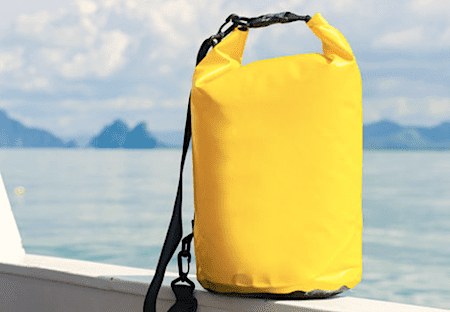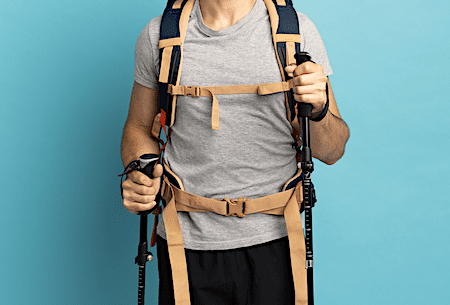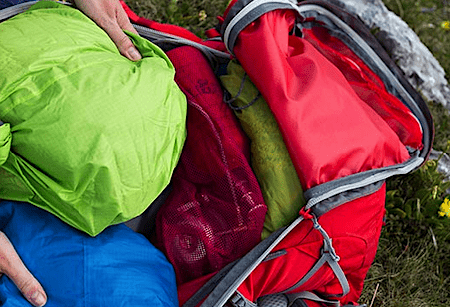If you’ve ever gone camping, you know there’s no shortage of things you need for your trip, from a sleeping bag to a rain poncho and even a hatchet.
At the very top of this list is your camping tent. After all, you won’t last long out in the wilderness without shelter.
But tents are heavy, and they are no fun to walk with when hiking, especially when you have lots of other stuff already stashed in your backpack.
Luckily, though, when you know how to attach tent to backpack the right way, you can prevent your back from having to work too hard while keeping everything snugly in place.
Wondering how to go about it? Read on to find out.
Getting The Tent Ready
It all starts with getting your tent ready. You must first prepare your tent before attaching it to your backpack.
Ensure you have a backpacking tent of excellent quality (no ordinary tent will do) before anything else, and proceed as follows.
#1. Spread Out The Tent
Firstly, you’ll want to spread the tent on a flat surface. Then, you should pack your tent poles neatly inside a bag and align them along the tent’s sides instead of the center.
This way, when you fold up the tent, these poles will support it.
#2. Roll The Tent Up
You’ll want the pole bag to align with your tent’s sides to ensure the tent stays rolled up. Continue with rolling the tent peg bag after a few rolls.
You will have improved tent support this way. Finish rolling up your tent.
#3. Place The Rolled Tent Inside The Tent Bag
You can easily manage the tent because of the support provided by the middle poles. Don’t forget to dry the tent completely before doing the packing.
Wet tents are hard to stuff, and they usually weigh more, making transportation more difficult.
#4. Keep Your Tent Dry With A Waterproof Bag
When folding tents, any water that gets into them can cause damage and mold to grow despite being water-resistant.
So, you must ensure you carry your tent in a waterproof bag to make it more resistant to those elements.
Attaching The Tent To Your Backpack
When you’ve correctly set up your canopy tent, you’re ready to strap it to your backpack.
It’s possible to connect your tent to your backpack in several ways. And the way you pack your backpack and the tent will determine how comfortable it is for you.
So it’s a good idea to test different methods and find one that works well for you.
While many campers use loops on their backpacks and their tent’s stuff sacks, some also prefer those old-fashioned external frames.
Let’s go over exactly how to handle each, along with other options.
#1. Use Loops To Attach Your Tent
You must ensure your tent bag has external straps and your backpack has closed loops to proceed with this method. You can then attach your packed tent to your backpack easily.
Simply thread the straps through the pack’s loops before tying them firmly together. Doing so will prevent the tent from swinging around throughout your hiking.
This approach is the most straightforward way to attach a tent to a backpack if it fits your gear.
#2. Use Your Backpack’s External Frame
It won’t be necessary to look for other options for attaching your tent if you have an external frame backpack.
These packs’ sole purpose is to carry heavier loads comfortably on a long hike such as a trail. You can also fix all your bulky equipment with a set of dedicated tie points to the frame.
Start by putting your tent at the base of your pack horizontally. After that, squeeze your tent with the two end straps and secure the buckles. The extra cords alongside the straps can also come in handy to fix your bag more snugly.
Here’s one thing you might be concerned about- this method may sometimes become uncomfortable for hikers when the bottom load gets close to touching their legs.
Other than that, it is a practical technique to employ since it gives you more space in your bag to carry other delicate objects.
#3. Use Compression Straps To Secure Your Tent
Compression straps help keep your backpack snug by squeezing it so the load remains steady and you’re more comfortable carrying it. You can also use these belts to attach your other camping gear to your bag.
In this method, you begin with placing your tent vertically between the two straps on each side of your pack. Next, secure the backpack using the clips connected to the first two belts.
With the remaining two, you’ll need to tighten the tent further to ensure it remains firm while you walk. And don’t forget to balance the bag and ensure its stability by attaching equipment to the other side.
This approach with compression bands can also be helpful when fixing your tent to the center back vertically.
#4. Utilize The Space In Your Internal Frame Backpack
Nowadays, internal frames are most common among framed packs. And if you have one of those, you can store your tent and other large equipment in its spacious middle section.
First, attach clips to each of the four corners in your tent bag. If you wish, you may also use a wire or bungee cord if it’s sturdy and flexible.
Next, slide those clips into the backpack’s loops inside and ensure they are tight and secure.
Once you have attached all the clips this way, stretch out the center of the tent’s bag until it’s nicely taut. Make sure each corner has its own matching clip inside the backpack so that everything fits tightly.
Essentially, you’ll want each side to have an equal share of attachments before tightening the clips. Therefore, it’s wise to adjust them a little until they all line up.
That way, your tent will sit snugly against your backpack once you tighten the clips.
#5. Attach The Tent To A Frameless Backpack
Light hikers often choose Osprey or similar frameless backpacks since they reduce the load significantly.
When you have such a pack, you can efficiently attach your tent by disassembling it and storing all its fabrics (inner tent, rainfly, footprint) in the pack’s stretchy middle pocket. The stakes and poles can then fit into either side.
Generally, the fabrics don’t weigh, so attaching them to the outside won’t make much of a difference, and if you place the poles at the sides, they’ll be closer to your center of mass, reducing the weight further.
Ultralight hikers use this method to get away with smaller backpacks, saving some noticeable weight.
It also eliminates any concerns regarding your other items getting wet with the inner tent and rainfly attached to the pack’s exterior.
#6. Staff Your Tent Inside The Backpack
There’s one more way to pack your tent conveniently in your backpack. Unlike other methods, it doesn’t require rolling up and packing your tent; instead, it only requires stashing it inside your pack.
The key to this technique is to make sure you pack all the bulky items from lightest to heaviest.
First, put your sleeping bag and spare clothing in the bottom of your backpack, and place the tent on top of it. You can also pack your tent poles along with the tent if you’ve got foldable ones.
If not, you’ll have to attach them separately to your backpack’s exterior.
You can use this method to ensure that the heavier items in your bag stay firmly in place while hiking without disrupting your balance.
Also, it can help protect your tent’s soft parts from getting damaged when they rub against bushes or other sharp objects.
A Few Additional Things To Consider
Besides the methods we discussed above, here are a few additional things you may want to consider when mounting a tent to a backpack.
- You should cover the poles’ tip with a cup or something similar to protect your backpack while you attach your tent poles vertically on the sides of your pack.
- If you disassemble your tent before packing, you can store your inner tent and rainfly in separate compartments in your backpack. It eliminates the need for the tent bag, reducing the weight considerably.
- Pack the heaviest items closest to your back, so the weight distributes across your entire body, rather than just your shoulders and back.
- Carrying your tent in your bag’s inner space will enable you to set up a fresh, dry tent when you arrive at your first camping spot.
- When attaching your tent to the outside, choosing the bottom instead of the top is better for maintaining a balanced center of mass.
- Tents are one of the heaviest pieces of gear you carry. Therefore, don’t be afraid to pay a little more for a lighter one.
Thoughts
A thoughtful packing of your gear is essential whenever planning your camping trip.
Your backpack is crucial for safely storing all your essentials while out in the wild, as is your tent, which is your only shelter.
Ultimately, what matters most is walking in comfort while protecting these essentials. And now that you know how to attach tent to backpack, you’ll have no problem when the time comes.
To conclude, I’d recommend going for a quick walk with the packed combo to test out which of the above methods works best for you so that you can decide wisely and prepare well for a lengthy trip.








